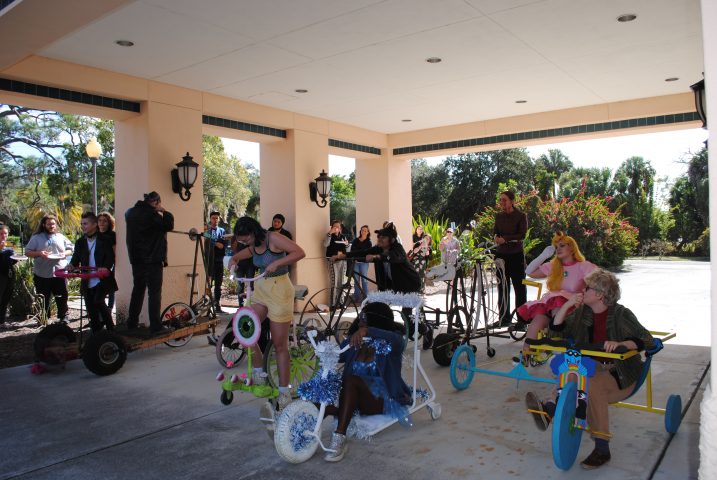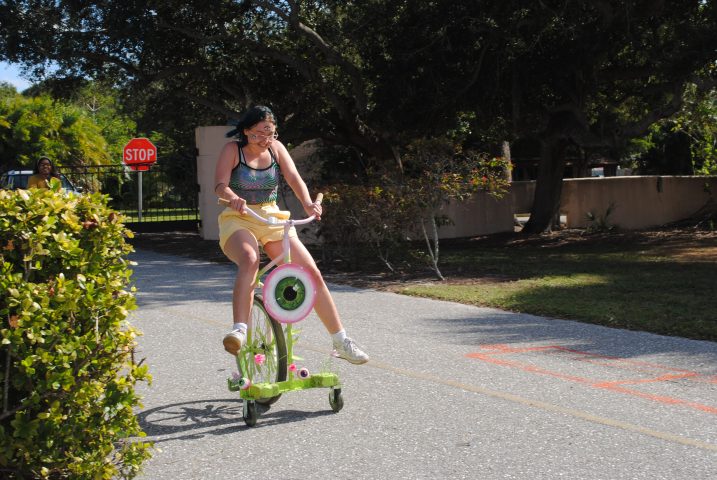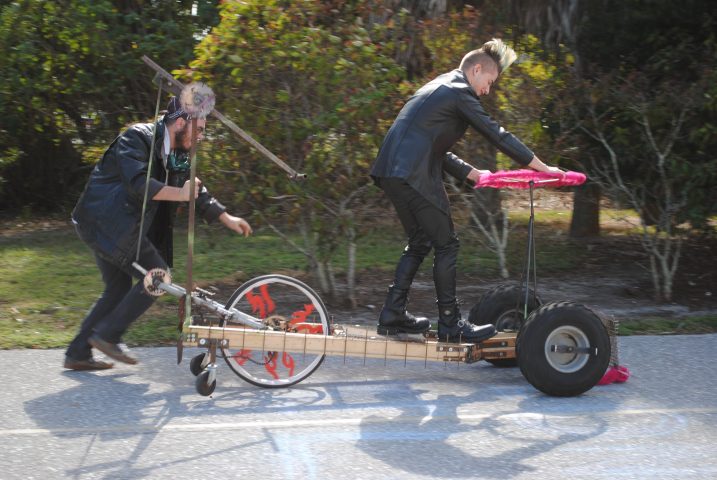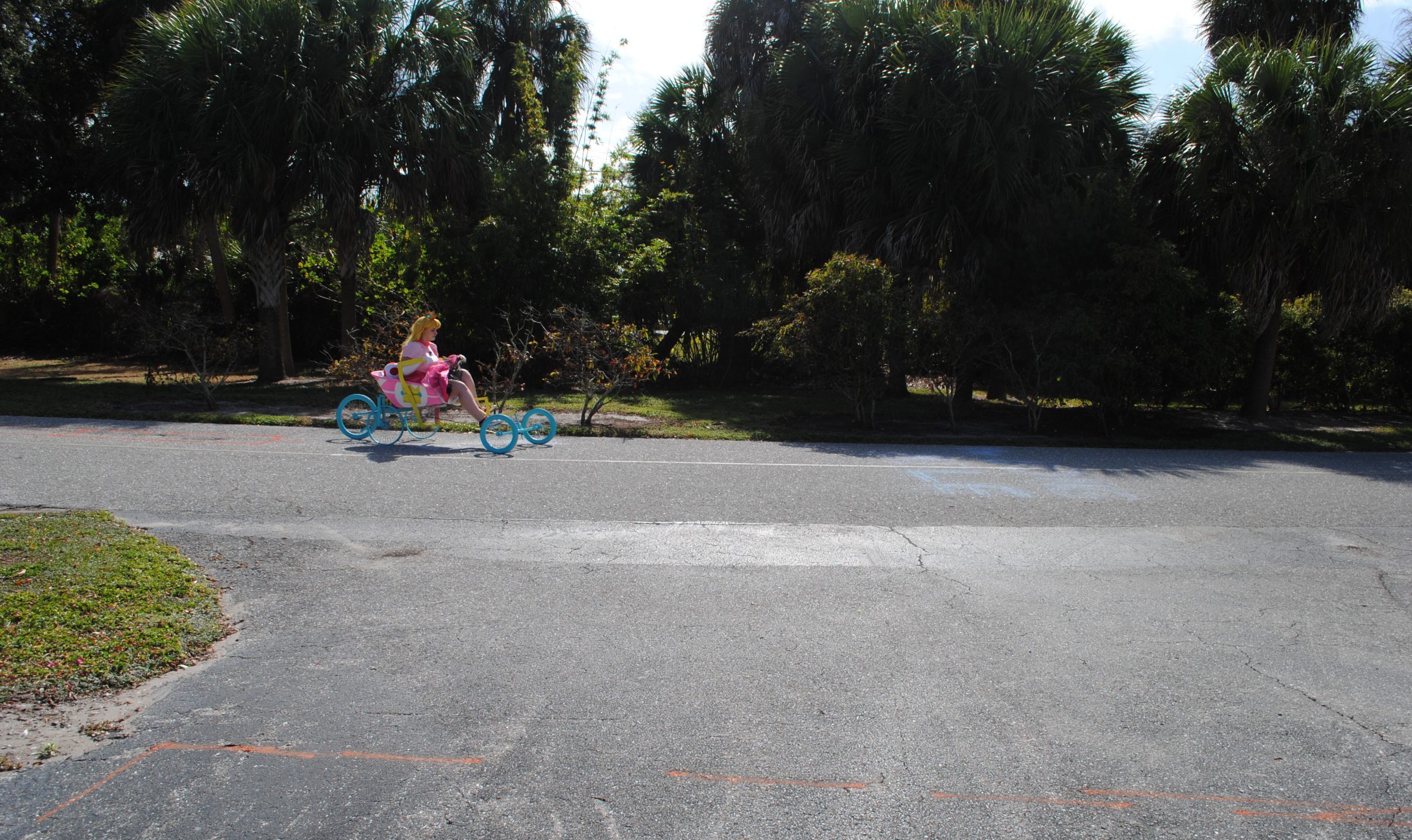
“On your mark, ready, go!” Buyssens cheered to the competitors. 
The eyes painted on winner third-year Garland Hanson’s face represent the “Monster” theme of the functional, yet elaborately designed bike. 
Second-years Gabe Sobel and Clayton Bauldree push their Anarchy vehicle to the finish line, using strength and determination.
On Monday, Dec. 2, students gathered around the Caples campus parking lot for the heavily-anticipated art showcase, Parking Lot Regatta. The eight bikes present were decorated according to each sculptor’s theme and elaborate costumes matched each vehicle. After a difficult race with many triumphs and setbacks, third-year Garland Hanson won with a monster themed bike.
Over the course of the class, students specialized in building the technical skills of machinery, welding, design aesthetics, metal work and kinetics essential to crafting a sculpture in motion.
“The class allows the specialization of certain techniques while also working within a theme or conceptual framework,” Professor of Art Ryan Buyssens said, “watching students improve their ability to creatively solve problems as they adapted to the rules limiting complete control of the project.”
Buyssens cited the industrial city of Detroit for his interest in art spanning multiple dimensions.
“I specialize in interactive art with programmed microcontrollers and sensors so that the art responds to the viewer and the viewer becomes a part of the art work,” Buyssens said.
Students gave the cars, nicknamed “land yachts,” a thematic scheme aligning with their costumes. The land yachts included “Anarchy” by Gabe Sobel and Clayton Bauldree, “Princess Peach” by Autumn Schwers, “Winter Wonderland” by Precious Darling, “The Beatles’ Yellow Submarine” by Keilon Sabourin, “Good Omens” by Claire Stout, “Chef” by Cindy Kim, “Wolf” by Kennon Gilson and “Monster” by Garland Hanson.
“They became very personal,” Buyssens said. “Everyone had a unique approach to their problems and brought out a lot of their own personalities to solve them.”
The range of directions students drove their art in was a challenge for Buyssens to manage as a teacher, but the individualistic approach stems from what Buyssens is highly concerned with: stressing the why behind art.
“We work within the conceptual framework of what does it mean,” Buyssens said.
“Throughout the class I have been able to explore many of the mechanisms that go into providing energy,” Clayton Bauldree, co-creator of “Anarchy,” said. With purple feather accents, the large rusted reversed tricycle is powered by a pump trolley mechanism.
Bauldree is part of the first group of students taking the Parking Lot Regatta course, which will be offered semi-annually.
“I wanted to take the course because I thought it would be a unique experience,” Bauldree said. “It’s not every year the chance to build a vehicle for academic credit comes up.”
Students explored the deconstruction of bikes and other mechanisms producing movement, “taking inspiration from their power mechanisms and creating our own version for our vehicle,” Bauldree said.
Part of the inspiration behind this event was a graduate school raft race that garnered much excitement from that institution’s student body. Aligning with the increase in community-related academic events, Parking Lot Regatta was an opportunity to bring students together to explore one aspect of the craft.
The bike “Winter Wonderland,” constructed by first-year Precious Darling, featured garlands, a snow blanket and decorative snowflakes.
“The starting point was learning the mechanics of bicycles: the axles, the wheels, the different kinds of metal, how to get the perfect weld,” Darling said.
In the near future, Buyssens plans to expand 3D arts at New College. He discussed the potential of focusing on different venues: “We’re approaching things not necessarily in a formal sculptural format, but thinking about non-verbal communication through 3D materials.”
Currently, he pursues several outlets in this vein: woodworking, mold making, visual fabrication and programming interactive art.
In order for students to get a holistic outlook, Buyssens wants to divvy up the different assignments of sculpture into separate, specialized classes like Parking Lot Regatta.
“Each class, we focus on one aspect, which is still a lot,” Buyssens said. “Students can come out the other end with a deeper understanding of things.”

